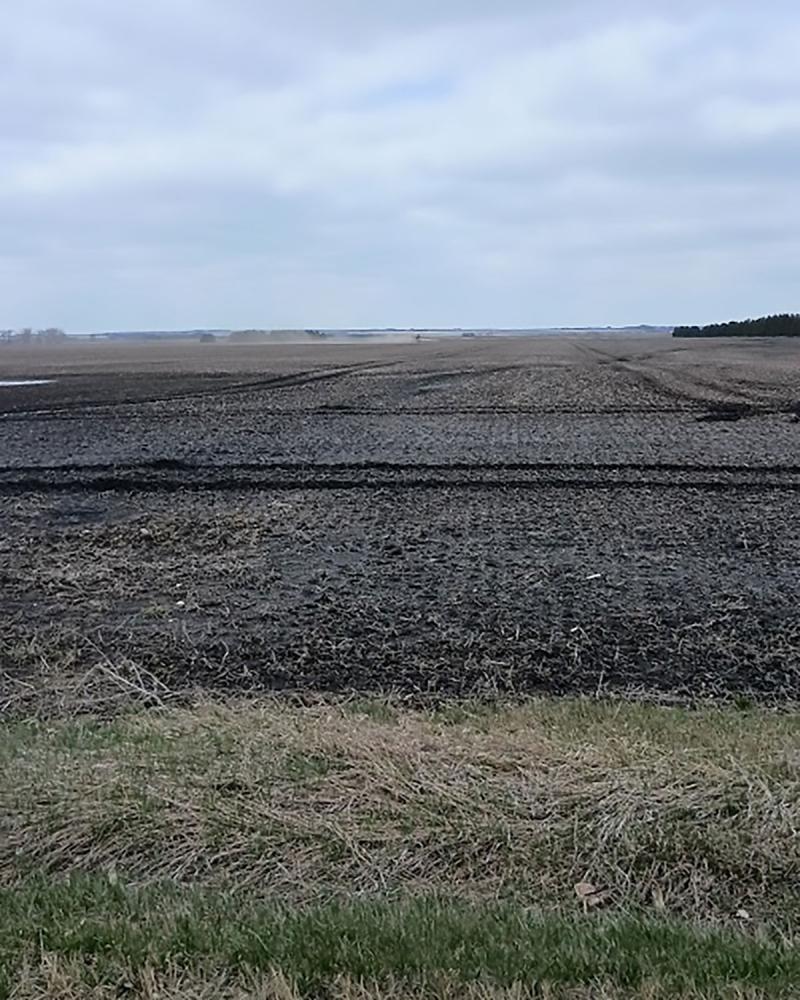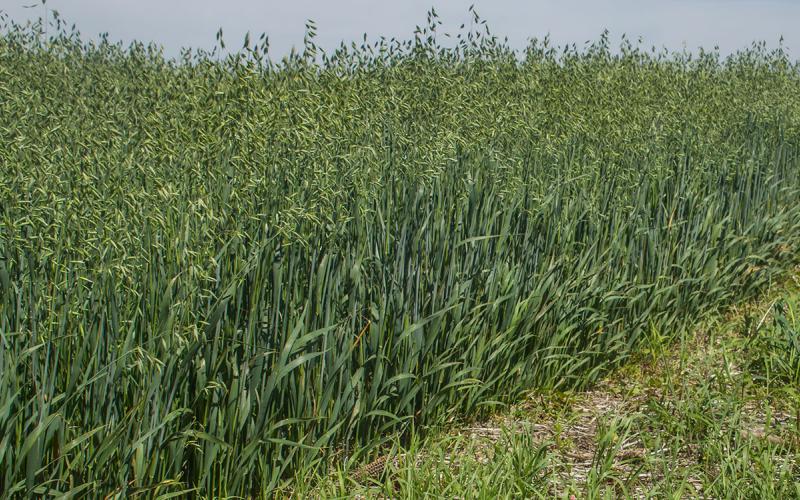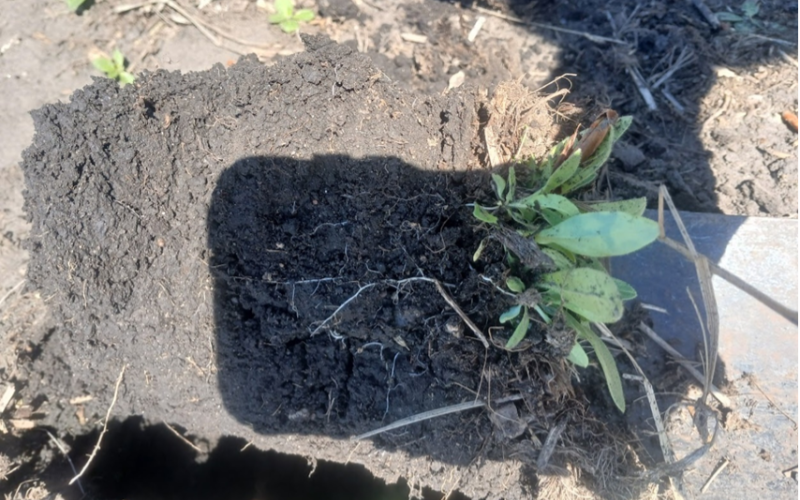This year in South Dakota many areas have received high amounts of rainfall during the summer. This has led to portions of fields being wet particularly in the northeastern part of the state. Soils that are a little dryer than field capacity are more susceptible to compaction than soils that are dryer or wetter. However, soils that are wetter than field capacity have a lower load bearing capacity than dryer soils. This is why deep tire tracks appear when driving over wet soil. A picture of tire tracks left in a field is shown in Figure 1.

When soil is dry there is little friction between soil particles which limits how much the soil can be packed. As soil water content increases it reduces friction between soil particles and increases how much soil can be compacted. When soil is wetter than field capacity water gets in the way and limits how much it can be compacted. Compaction can degrade soil health by reducing soil pore space and destoying soil aggregates. Having less aggregates and macropores in the soil can lead to reduced water infiltration and aeration and poor soil drainage. This can cause increased soil erosion and reduced soil biological activity. Also soil compaction can lead to reduced crop yields of up to 10-20% over the long term (Sonderegger & Pfister, S. 2021).
Monitor Soil Moisture Content
Identifying how wet the soil is before entering the field with equipment is a key step to avoid compaction. An easy way to identify this is to walk into the field with a shovel or soil probe and look at the soil by sticking the probe or shovel into the ground. If soil near the surface feels plastic or moist the field should not be driven on. If the soil is dry near the surface, it is ok to drive equipment on the field. Also, if there is standing water in the field the crop should not be harvested.
Many fields in South Dakota have depressional areas and or varying soils where some spots may dry out faster than others. This creates difficulty when harvesting these fields. If compaction is a concern in a field waiting to harvest the portion of the field that is wet until it dries out may be a good idea.
Minimize How Much of Field is Trafficked
Much of the compaction that is caused by a load occurs on the first pass that occurs when a load is driven over an area. If additional equipment in addition to a combine is driven through a field the equipment should follow in the combine’s track. When unloading the combine into trucks the same location in the field should be used. When chopping silage the truck should follow in the chopper tracks if possible. Combines should be unloaded into trucks or grain carts at the same location in the field to decrease how much of the field is compacted. Loading grain trucks by the field access point would be the best idea to limit how much traffic drives into the field.
Have Proper Air Pressure in the Tires
Having the correct air pressure in tires can reduce how much force is applied to the soil. Having too much pressure in tire reduces the percentage of the tire that touches the ground. This leads to greater compaction occurring from the equipment. When there is lower air pressure in the tire the load is spread out across a larger area which reduces how much compaction occurs. However, the air pressure in the tire should not be reduced to the point where excessive sidewall wear occurs.
Spread Load Over a Larger Area
As the weight over an area increases there is a larger force applied to the soil surface. One method used to reduce the force applied over an area is to install tracks on harvesting equipment. Tracks help to spread the load of the agricultural over a larger area. Also, using dual tires and or larger or wider tires can spread the weight of the tractor over a larger area. Spreading the weight of the equipment over a larger area can minimize the amount of compaction that occurs.
Methods to Remove and Mitigate Soil Compaction Risks
Once soil becomes compacted there are some methods available to deal with compaction. One method is strategic tillage to loosen up the soil. This practice is probably the most common practice used. Tillage should be done that goes below the compacted layer to allow water to infiltrate through the compacted layer and increase the soil porosity. If tillage is done to mitigate soil compaction it should be done when soil is dry. Tillage can create compacted layers deeper in the soil if done when the soil is too wet. However, this practice is a temporary fix and does not reduce the soil compaction potential. Tillage adds oxygen to the soil which increases the rate that organic matter is broken down. Soils with lower organic matter content are more susceptible to compaction than ones with higher organic matter content.
Using soil health practices such as cover cropping, no tillage, retaining residues, multiple crop rotations and addition of organic amendments such as manures is another practice that reduce compaction risk and mitigate compaction risks. Keeping crop residues in the field will help to protect the surface from compaction, increase soil organic matter content and help to create soil structure. Using no tillage will help to increase soil organic matter which can help to create soil structure and porosity. However, using no tillage alone on compacted ground may have low crop yields for the first few years until structure can be created and organic matter begins to increase. It would be best to combine no tillage with a cover crop and a multiple crop rotation on compacted ground. Planting cover crops is a good practice that can help to break up compaction. Cover crops can create soil pores, increase soil organic matter content and provide cover on soil surface to protect the soil. If producers are just planting corn and soybeans cover crop selection is limited to winter hardy cover crop species such as winter rye. Planting a multiple crop rotation including crops such as oats, wheat or rye provides a good opportunity to include cover crops with a variety of root structures and depths to help to break up compaction. This will allow the inclusion of deep-rooted species such as radish and sunflowers with species that have shallower rooting systems such as oats or rye. Planting a multiple crop rotation will allow the inclusion of crops with a variety of rooting structures and allow inclusion of a variety of cover crop species. This practice also will increase soil organic matter content and aggregation. Addition of organic amendments such as manure can increase soil organic matter content which will help to create soil structure and the increase the soils ability to buffer against compaction. Also, all these soil health practices should help to increase soil biology which can help to create pores and aggregates.
Summary
Soil compaction can degrade soil health and lead to reduced crop yields. Practices that can be done to avoid soil compaction is stay out of the field when wet, minimize the amount of field that equipment in drove over, have proper tire pressures, and spread the weight over a larger area. To mitigate the effects of compaction strategic tillage can be done along with practices to improve soil health. Avoiding field operations when the soil is wet along with reducing the amount of field that is driven over by equipment is the best practice to avoid yield loss and degradation to soil health from equipment during harvest.
Reference
Sonderegger, T., & Pfister, S. (2021). Global assessment of agricultural productivity losses from soil compaction and water erosion. Environmental Science & Technology, 55(18), 12162-12171.


